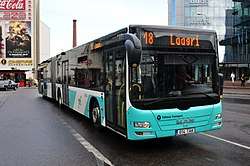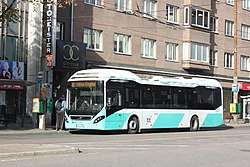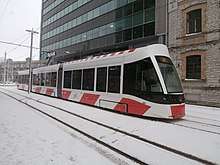Public transport in Tallinn
Public transport in Tallinn consists of bus, tram, trolleybus, train and ferry services. Bus, tram and trolleybus routes are mainly operated by Tallinna Linnatranspordi AS. Electric train services are offered by Elron and the ferry service to Aegna island is operated by Kihnu Veeteed.


Tram, trolleybus and bus services used to be divided between Tallinna Autobussikoondis (bus services) and TTTK (tram and trolleybus lines), but these companies were merged in 2012 into Tallinna Linnatranspordi AS (TLT).[1]
Tallinn is the only city in Estonia to have ever used trams or trolleybuses. The first tram route was opened in 1888, and in 2008 the tram celebrated its 120th anniversary. Trolleybuses were first planned for Tallinn in 1946, but the first route to open commenced services in 1965. Since then the trolleybus network was expanded to nine routes however operations began to be scaled back. In 2000 one route was closed followed by another in 2012 followed by two further routes closing in 2015, and another one route in 2017 leaving four lines remaining.
A light rail service in Tallinn has been planned since the 1970s. The project halted when Estonia became independent from the Soviet Union, but in the 2000s the planning resumed. The light rail would start in the city center, usually at Vabaduse väljak (Freedom Square) or Viru keskus (Viru shopping center) and finish in East Lasnamäe, having 10–12 stations.[2]
All trains depart from the Balti jaam just at the northern end of Tallinn's Old City. Elron offers local EMU services to Keila, Paldiski and Riisipere in the west and Aegviidu in the east, as well as DMU services to Pärnu, Viljandi, Tartu and Narva, replacing Edelaraudtee on these lines since January 2014. Currently Elron operates Stadler FLIRT EMU and DMU trains.
Systems
Bus
Internal
Bus routes can be found almost everywhere in Tallinn. Nearly everywhere, especially in Pirita, Lasnamäe and Nõmme they provide the backbone of the public transportation system, as these districts don't have trams or trolleybuses (except Nõmme, through which the Elron western direction trains go).[3]
The routes and timetables are set by Tallinna Transpordiamet (Tallinn Department of Transportation). The contracts are renewed every 5 years. The route numbers in Tallinn consist of one or two numbers, occasionally accompanied by a letter A or B. There has also been a special Park & Ride bus route 1PR, which was opened in September 2007 and offered service between the Pirita Park & Ride parking lot and the city center. The route was closed from January 2009.
Nearly all routes have two terminus stops, one of which serves to drivers also as a resting stop.
Tallinn doesn't have much "feeder lines", which take passengers to another means of transport. For example, bus route no. 57 has been shortened to a tram terminus; bus route 25, which departs just 5 times on weekdays, takes passengers to the two trolleybus terminuses in Mustamäe, partially similarly to bus route #37; bus route 21A using to takes passengers to the trolleybus terminus in Väike-Õismäe.
Routes are mostly operated between 5:20 and 0:20 throughout the day. Some bus routes, mainly the express routes operate only during peak hours and have a break between 10–11 in the morning and 2–3 in the afternoon. From 1 September 2012, express routes will have the same ticket price as regular bus routes.
From 7 November until the end of 2008 the Department of Transport carried out a pilot project, during which popular bus and trolleybus routes' operating times were prolonged until 1 am (did not continue). Also, there have been talks of night bus lines, but currently there are night bus, tram and trolleybus lines only on New Year's nights.
Since 1 January 2013 all public transport has been free of charge for people registered as living in Tallinn.
Regional
Regional bus routes are managed by the Harjumaa Ühistranspordikeskus (HÜTK) (Harju County Public Transportation Center). The Center was established in early 2005. The establishers were the 25 local governments of Harjumaa and the Government of the Harju County as the representative of the Republic of Estonia. The goal of the center is to arrange public transportation in Harju County to raise quality of the service provided. The routes are drawn by HÜTK and then given to different operators. There are also about 50 commercial lines in Harju County.
As of 1 November 2008, a zone system was introduced for public suburban routes. Harju County is divided to 4 zones, with the first one being Tallinn, second the surroundings of Tallinn and the rest are determined by the distance from Tallinn. Travelling within a zone will cost 12 EEK, and driving to another zone will cost an extra 10 EEK. The zone system replaces the current ticketing system, where the cost was determined by the distance driven—for example, if a route passes through a lot of villages instead taking a shortcut using the highway, the ticket would cost more.
Tram

The tram network is fairly short and serves the city centre with its surrounding areas. There are 4 tram lines and two types of trams—Tatra KT4 and KTNF6, which basically is a KT4 with a lowered middle-section. 20 new CAF Urbos AXL trams started service from 2015 to 2016.[4] First new tram went into service on 31 March 2015. A line 4 extension to Tallinn Airport was opened on September 1st 2017, consisting of 2 new stops: Ülemiste linnak and Lennujaam (airport). A tunnel was built to bypass the train tracks by Ülemiste jaam.
The tram system is operated by TLT.
Trolleybus
.jpg)
Trolleybuses serve the western part of Tallinn, Mustamäe and Haabersti districts especially. Trolleybus service began in 1965 with a route from the Estonian National Opera "Estonia" to Hipodroom (Hippodrome). Currently there are 4 routes: 1, 3, 4 and 5 from city center to Mustamäe. On 1 December 2012 trolleybus line nr 2 and on 2 May 2017 trolleybus line nr 9 were replaced by diesel buses. [5][6]
Commuter train
.jpg)
The Elron commuter trains are especially meant for the Harju County residents for a connection to Tallinn. Routes are also used by city residents, especially of Nõmme district. Railway lines pass through Kristiine, Nõmme and Lasnamäe districts of the city, with terminus stop Balti jaam being located in the Central district close to Põhja-Tallinn. Railway transport is free for registered city residents inside the city borders (1st zone): till Vesse stop on Eastern line, Laagri stop on Western line and Männiku stop on South-Western line.[7]
Ferry
Tallinn has a ferry connection to Aegna island, operated by Kihnu Veeteed. Since Aegna doesn't have many residents, the ferry is mostly for tourists and is operated only summertime. City residents can use the ferry for free.[8]
Tickets
All Tallinn bus, tram and trolleybus routes belong to a unified ticket system. Harju County routes and commuter trains (Elron) have a different fare system, which depends on the distance traveled.
In a public opinion poll on 25 March 2012, over 75% of the participants answered "yes" for fare-free transit on Tallinn's public transport system. Public transport has been fare-free for Tallinn residents since 1 January 2013,[9] making Tallinn the first European capital abolishing fares for city residents. Later, Elron and Tallinn City council reached an agreement, which makes urban routes (1st zone) free for city residents.
In spite of this, the public transport network is not completely fare-free, as fares continue to be charged to non-residents (including tourists and visitors) to the city.
Ticket types
Registered residents of Tallinn who have their ID cards and validated Public Transport Card (Ühiskaart) or equivalent student ID can travel free of charge on buses, trams and trolley buses in Tallinn from 1 January 2013 and on commuter trains within city borders since October 2013. Single tickets (talong), valid for single boarding, can be bought from vehicle drivers.
Non-residents can use the travel card for loading cash for single tickets, different period tickets and other special tickets. Single tickets can only be purchased from driver, all other tickets can be purchased by either validating a pre-loaded smart-card on a validator in every vehicle or online purchase. Discount tickets are eligible to use for students, pensioners and disabled people. Besides residents, anyone under the age of 7 may ride for free. Estonian citizens from 65 or over also ride for free.[10] Also passengers with children under 3 years of age can ride for free.
Fare collection
In Tallinn, most public transport vehicles operate on a proof-of-payment system, and can be entered from any door. As of July 2008, Tallinn Municipal Police fare inspectors randomly check tickets, stopping vehicles at stops so no one can leave the vehicle unnoticed. A fine (maximum of €40) is charged to any passenger without a valid ticket. If a passenger has forgotten his/her ID-card, then he/she can tell the ticket controller his/her social security number, which, in case the person has a valid ticket, proves the right of travelling. Since 1 January 2013, fare-free travellers (except those who could travel for before) have to validate their Public Transport Card; if they fail to do so, or if they fail to show their ID card, they can be fined €40.
References
- "About Tallinna Linnatranspordi AS".
- "Uued trammiliinid ootavad linnajuhtide liisu langemist" (in Estonian). 26 October 2007. Retrieved 13 July 2008.
- Elron
- "CAF-Construcciones y Auxiliar de Ferrocarriles, your railway solutions".
- 2. liini trollid asendatakse bussidega (in Estonian)
- Pealinn:Trolliliin number 9 suletakse alates maist (in Estonian)
- "Tallinlase tasuta sõit Elron rongides".
- "KIHNU VEETEED". Archived from the original on 1 July 2015. Retrieved 14 November 2014.
- "Lenta.ru: Бывший СССР: Мэрия Таллина отменила плату за общественный транспорт".
- https://www.tallinn.ee/eng/pilet/The-Right-of-Free-Travel
External links
| Wikimedia Commons has media related to Public transport in Tallinn. |